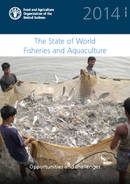Publicaciones
Fisheries and aquaculture play a vital role in achieving FAO’s Strategic Objectives of eliminating hunger, food insecurity and malnutrition. As reported in this edition of The State of World Fisheries and Aquaculture, people have never consumed so much fish or depended so greatly on the sector for their well-being as today.
As the demand for fish increases, the sector is also striving to be more productive and sustainable and to enable more inclusive and efficient systems...
The paper reviews the role fish plays in human nutrition and looks at the impact fish trade might have on food security and nutrition. Fish is recognized as an excellent source of protein but also plays a particular role in providing essential fatty acids and micronutrients deficient in many diets.
International trade has allowed developing countries to export high value fish and in many cases allowed them to purchase a large quantity of low value but...
Policy recommendations for small-scale fisheries and aquaculture trade.
This technical paper focuses primarily on price transmissions in small-scale and large-scale fishery and aquaculture value chains in 14 developed and developing countries. Although the study is focused on the small-scale sector, both the small-scale and large-scale sectors were analysed in order to demonstrate differences between the two. The document begins with an overview of the entire project and its global implications, reviewing the importance of fisheries and...
With the world’s population expected to reach 8.2 billion people by 2030, and with 842 million people estimated as having been undernourished in the period 2011–13, food supply will present a growing challenge in the next two decades.
With increases in income along with demographic changes related to family size, population ageing and urbanization, and consumer trends such as concerns for healthy eating and sustainable production, there will be great shifts in demand and major changes...
Carrageenan seaweed farming based primarily on the cultivation of Kappaphycus and Eucheuma species has grown significantly in the Philippines and Indonesia in the last two decades. Growth has also taken place on a smaller scale in the United Republic of
Tanzania and a few other developing countries. Thanks to attributes such as relatively simple farming techniques, low requirements of capital and material inputs, and short production cycles, carrageenan seaweed farming has become a favourable livelihood source for smallholder farmers or...






